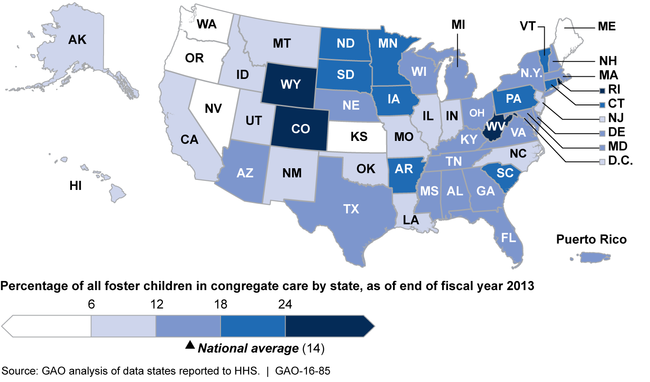Foster Care: HHS Could Do More to Support States' Efforts to Keep Children in Family-Based Care
Highlights
What GAO Found
Eight states GAO reviewed had a variety of efforts under way to help ensure they placed foster children in family-based settings rather than in group homes or institutions, also known as congregate care. Federal law requires that foster children have a case plan designed to achieve placement in the least restrictive (most family like) and most appropriate setting available, consistent with their needs. States' efforts to ensure appropriate placements included more oversight of decisions to place children in congregate care and the length of stay; enhanced recruiting and training for specialized foster families to care for children with serious emotional, behavioral, or medical problems; and increased supports for families in crisis. Officials in the eight states generally credited these efforts with declines in their use of congregate care—on average a 47 percent decline from fiscal years 2004 through 2013, based on the most recent available data from the Department of Health and Human Services (HHS). However, these states' percentages of foster children in congregate care still ranged from 5 percent to 34 percent, mirroring the variation nationwide in fiscal year 2013.
Percentage of Foster Children in Congregate Care by State (Sept. 30, 2013)

Selected stakeholders (state officials, service providers, and experts) cited challenges to more appropriate use of congregate care, such as providing specialized training to foster families, addressing shortages in mental health and other community services, and working with congregate care providers to focus more on providing services in family settings. In a May 2015 report, HHS said that states' progress in reducing congregate care was inconsistent and recognized that additional information was needed. HHS also proposed some relevant legislative changes. Stakeholders identified other HHS actions, such as additional data analysis and sharing of best practices that would help states facing challenges to transform their use of congregate care. HHS currently does not have plans to take further actions to support states.
Why GAO Did This Study
About 14 percent of the more than 400,000 children in foster care nationwide lived in congregate care at the end of fiscal year 2013, according to HHS data. Given the importance of family-based care to foster children's well-being, GAO was asked to review state use of congregate care.
This report examines (1) how selected states have reduced their use of congregate care; and (2) some challenges with reducing congregate care placements, and efforts HHS has taken to help states reduce congregate care. GAO analyzed child welfare data from HHS; reviewed relevant federal laws, regulations, and documents; and interviewed state child welfare officials in eight states--Connecticut, Colorado, Kansas, Louisiana, Maryland, Minnesota, New Jersey, and Washington. In four of these states, GAO also visited and spoke with local child welfare officials and congregate care providers. The selected states varied in their use of congregate care and geographic location, but cannot be generalized nationwide. GAO also spoke with child welfare experts.
Recommendations
GAO recommends that HHS take steps to enhance its support of state actions to reduce use of congregate care as appropriate, by, for example, collecting additional information on state efforts and sharing best practices. HHS concurred with this recommendation.
Recommendations for Executive Action
| Agency Affected | Recommendation | Status |
|---|---|---|
| Department of Health and Human Services | HHS should take steps to enhance its support of state actions to reduce the use of congregate care as appropriate. These steps could include: (1) collecting additional information on states' efforts to reduce their use of congregate care; and (2) identifying and sharing best practices with the states and providing technical assistance that states could use to address challenges in the areas of building capacity for family placements, addressing shortages of needed services, improving assessments, and retaining sufficient numbers of congregate care providers, or other areas as needed. |
HHS concurred with this recommendation. As we noted in the report, HHS' FY16 President's budget request included a proposal to amend title IV-E to provide support and funding to promote family based care for children with behavioral and mental health needs as well as provide oversight of congregate care placements. In addition, at the time of our report's publication, HHS stated that it offers individualized technical assistance to child welfare agencies and at that time, two public child welfare agencies were receiving assistance from HHS through a Title IV-E waiver demonstration program. Since our report was issued, HHS has taken several steps to implement this recommendation. In August 2016, HHS reported that the Children's Bureau Child Welfare Capacity Building Center for States began planning an extensive capacity building effort targeted at reducing the numbers of children/youth in congregate care. The effort entailed developing a toolkit to showcase promising practices such as: assessment processes used when children/youth are being referred to congregate care, efforts that stabilize behavioral health concerns for children/youth in congregate care, and efforts to prevent children/youth from being placed in congregate care. The agency also undertook efforts to develop a national dialogue to support peer-to-peer learning among state leaders to share practices that have been shown to be effective in keeping children/youth in the least restrictive environments as possible. In June 2017, the agency published a guide to help child welfare administrators, supervisors, workers, and private agencies enhance their capacity to use congregate care. The guide, entitled "Working with Children/Youth With Complex Clinical Needs: Strategies in the Safe Reduction of Congregate Care", is available on the agency's website and was announced to child welfare stakeholders.
|
